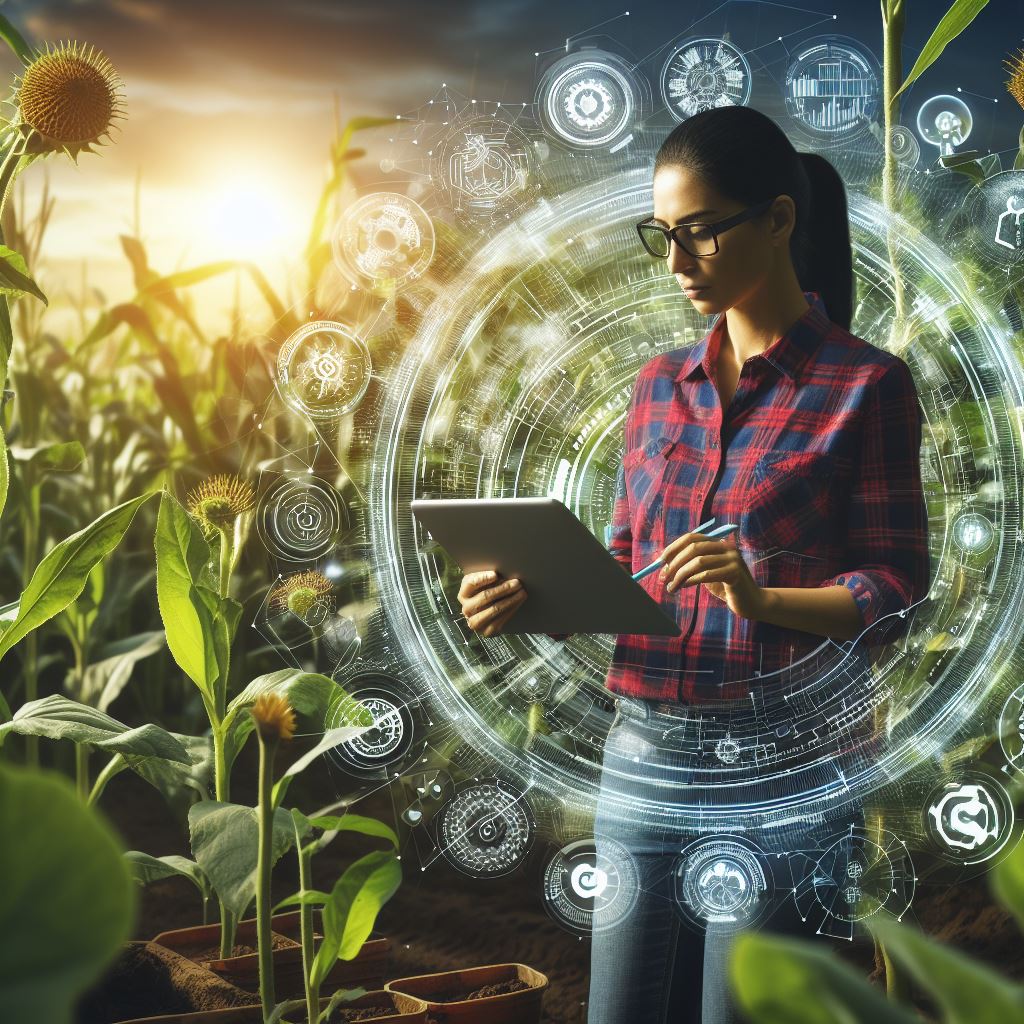Introduction
The importance of technology in agriculture cannot be overstated. It has revolutionized modern crop cultivation.
Tech tools are playing a transformative role in modern crop cultivation practices.
Thanks to technology, farmers now have access to a wide range of tools that simplify their work.
These tools include drones, precision agriculture systems, and sensors that monitor soil health.
Drones are used to survey large farms, providing valuable data on crop health and identifying problem areas.
Precision agriculture systems help optimize resource usage by enabling farmers to apply fertilizers and pesticides more efficiently.
Sensors monitor soil moisture levels, allowing farmers to irrigate their crops more effectively and avoid water wastage.
Data analytics applications are also being used to assess crop yield and predict disease outbreaks.
By embracing technology, farmers can maximize crop yields, reduce waste, and ensure sustainable farming practices.
The integration of tech tools into crop cultivation has led to higher productivity and profitability.
Moreover, technology has made agriculture more environmentally friendly by minimizing the use of harmful chemicals.
In general, tech tools have transformed modern crop cultivation, making it more efficient, effective, and sustainable.
Precision Agriculture
Modernizing crop cultivation, precision agriculture employs advanced technology to optimize farming practices.
- GPS and satellite technology play a crucial role in precision agriculture.
- These technologies provide farmers with accurate information about their fields, such as soil moisture levels and nutrient content.
- Farmers can use this data to make informed decisions about when to irrigate, fertilize, or apply pesticides.
Precision agriculture tools such as drones, sensors, and GIS technology
One example of precision agriculture tools is drones.
These unmanned aerial vehicles can collect aerial imagery and other data about the crops.
- Drones equipped with imaging sensors can provide high-resolution images of fields, allowing farmers to detect crop diseases or nutrient deficiencies.
- By identifying specific areas that require attention, farmers can target interventions and minimize the use of chemicals.
Sensors are another essential tool in precision agriculture.
They can be deployed in fields to collect real-time data on various parameters.
Transform Your Agribusiness
Unlock your farm's potential with expert advice tailored to your needs. Get actionable steps that drive real results.
Get Started- For example, soil moisture sensors can help farmers determine when and how much to irrigate, reducing water waste.
- Other sensors can measure temperature, humidity, and even pests or diseases, enabling farmers to take proactive measures.
Geographic Information System (GIS) technology is also used extensively in precision agriculture.
- GIS combines data from multiple sources, such as soil samples, weather information, and satellite images, to create detailed maps.
- These maps help farmers identify specific areas within their fields that need attention, improving resource allocation.
- By precisely targeting the application of fertilizers or pesticides, farmers can reduce costs and minimize environmental impact.
In fact, precision agriculture revolutionizes modern crop cultivation by leveraging advanced technology.
The use of GPS and satellite technology in precision agriculture
- The use of GPS and satellite technology, along with drones, sensors, and GIS technology, enhances farming practices.
- By providing accurate data and insights, these tools enable farmers to optimize resource allocation and reduce environmental impact.
- Ultimately, precision agriculture contributes to increased yields, improved profitability, and sustainable farming practices.
Read: Seasonal Guide to Vegetable Farming Success
Automation in Crop Cultivation
Overview of Automation and Its Benefits in Crop Cultivation
- Automation is revolutionizing the field of crop cultivation, making it more efficient and productive.
- It offers several benefits including increased yield, reduced labor costs, and improved crop quality.
- By automating repetitive tasks, farmers can allocate their time and resources more effectively.
- Automation also enables accurate data collection, leading to better decision-making and optimized farming practices.
Explanation of Autonomous Machinery such as Robot Harvesters and Tractor Guidance Systems
- Robot harvesters are autonomous machines designed to perform the task of harvesting crops.
- These robots use computer vision and sensors to identify ripe crops and harvest them with precision.
- They can work tirelessly for extended periods, ensuring a timely and efficient harvest.
- Tractor guidance systems also utilize automation by using GPS and sensors to navigate the fields.
- They eliminate human errors in tasks such as planting, spraying pesticides, and fertilizer application.
- These systems enable precise control and reduce chemical usage, resulting in sustainable farming practices.
The Use of AI and Machine Learning in Improving Crop Cultivation Processes
- Artificial Intelligence (AI) and Machine Learning (ML) play a crucial role in modern crop cultivation.
- AI algorithms analyze vast amounts of agricultural data, providing valuable insights for farmers.
- ML techniques enable predictive analytics, helping farmers make proactive decisions based on historical trends.
- AI-powered systems can monitor soil conditions, weather patterns, and pest infestations in real-time.
- This information allows farmers to optimize irrigation, pest control, and other critical factors for crop growth.
- AI-driven systems can also detect diseases early, preventing their spread and minimizing crop losses.
- Machine learning models can analyze crop images to identify nutrient deficiencies and optimize fertilizer application.
- By integrating AI and ML into crop cultivation processes, farmers can maximize yield and minimize resource wastage.
- These technologies enable precision agriculture, ensuring every plant receives the right treatment at the right time.
In short, automation is changing the face of crop cultivation.
Autonomous machinery such as robot harvesters and tractor guidance systems increase efficiency and productivity.
AI and machine learning enhance decision-making and optimize farming practices.
Implementing automation technologies in crop cultivation processes is crucial for sustainable and successful agriculture in the modern world.
Read: Precision Agriculture: Tech in Crop Cultivation

See Related Content: Tomato Harvesting: Techniques for Quality
Data Analytics and Predictive Modeling
Data analysis plays a crucial role in modern crop cultivation, enabling farmers to make informed decisions and improve their crop yields.
With the advent of IoT and sensors, collecting farm data has become easier and more efficient.
This data, when analyzed using advanced analytics techniques, can provide valuable insights and predictive models that can optimize crop yields and reduce resource wastage.
Importance of Data Analysis in Crop Cultivation
Data analysis is fundamental in understanding the current state of crops and predicting their future growth patterns.
By analyzing data such as soil composition, weather conditions, and pest infestation, farmers can gain a comprehensive understanding of their crops’ health.
This knowledge enables them to identify potential issues early on and take timely preventive measures.
Use of IoT and Sensors in Collecting Farm Data
IoT devices and sensors have revolutionized data collection in agriculture.
These devices can be deployed in fields to collect real-time data on various parameters such as soil moisture, temperature, humidity, and light intensity.
The data is then transmitted wirelessly to a central system for analysis.
This real-time monitoring allows farmers to make informed decisions and take proactive steps to ensure optimal crop growth.
Benefits of Data Analytics and Predictive Modeling
By leveraging data analytics and predictive modeling, farmers can optimize crop yields and reduce resource wastage in several ways:
- Optimized Resource Allocation: Data analysis helps farmers identify areas where resources like water, fertilizers, and pesticides are being under or overutilized. By optimizing resource allocation based on data insights, farmers can reduce wastage and ensure efficient resource utilization.
- Predictive Crop Growth: Using historic and real-time data, predictive models can forecast crop growth patterns. This empowers farmers to anticipate yield fluctuations, disease outbreaks, or weather-related risks. By taking preventive measures ahead of time, farmers can minimize crop losses and mitigate risks.
- Precision Farming: Data analytics allows farmers to implement precision farming techniques. By analyzing data collected from sensors, farmers can fine-tune irrigation schedules, adjust nutrient levels, and optimize planting patterns. This precision farming approach maximizes crop productivity while minimizing the use of resources.
- Improved Pest and Disease Management: Data analysis can help identify early signs of pest infestations or disease outbreaks. By analyzing patterns and correlations, farmers can take immediate action to prevent the spread and minimize crop damage. This targeted approach reduces the reliance on broad-spectrum pesticides and saves costs.
- Efficient Harvesting: Predictive models can estimate the optimal time for harvesting based on various data inputs. By harvesting at the right time, farmers can ensure that their crops are at their peak quality and nutritional value. This not only improves marketability but also reduces the risk of spoilage.
Data analytics and predictive modeling revolutionize crop cultivation.
Farmers leverage data for informed decisions, optimizing resource allocation and maximizing yields. Integration of IoT and sensors enhances real-time monitoring for proactive farming.
As technology evolves, limitless potential exists for data-driven advancements in crop cultivation.
Read: Cover Crops: Advantages in Crop Management
Crop Monitoring and Management Systems
Overview of Crop Monitoring Systems and Their Significance
Crop monitoring systems play a crucial role in modern crop cultivation by providing real-time data.
These systems monitor various factors like weather conditions, soil moisture, and nutrient levels.
Farmers can use this data to assess the health and growth of their crops, enabling informed decision-making.
By detecting potential issues early on, farmers can take corrective actions and minimize crop losses.
The significance of crop monitoring systems lies in their ability to improve crop yield and optimize resource utilization.
Remote Sensing and Satellite Imagery in Monitoring Crop Health and Conditions
Remote sensing uses satellite imagery to capture data about the Earth’s surface, including agricultural land.
Satellite imagery helps monitor crop health and conditions by providing detailed and accurate information.
By analyzing the images, farmers can identify stress factors like water scarcity, nutrient deficiencies, or pest infestations.
These insights enable proactive measures such as targeted irrigation, fertilization, or pest control.
Remote sensing and satellite imagery revolutionize crop monitoring by providing a bird’s eye view of large agricultural areas.
The Use of Smart Irrigation Systems and Crop Management Software
Smart irrigation systems integrate data from various sources like weather forecasts and soil moisture sensors.
They use this information to optimize irrigation schedules, ensuring crops receive the correct amount of water.
These systems prevent overwatering, which can lead to water wastage and leaching of nutrients.
Furthermore, they save farmers time and effort by automating irrigation tasks, increasing efficiency.
Crop management software complements smart irrigation systems by providing comprehensive tools for planning and analysis.
Farmers can track crop growth, input usage, and make informed decisions using data-driven insights.
Crop monitoring and management systems empower farmers with real-time data and insights to make informed decisions.
By leveraging remote sensing, satellite imagery, smart irrigation systems, and crop management software,farmers can monitor crop health, optimize resource utilization, and mitigate potential risks.
These tech tools are transforming modern crop cultivation, enabling sustainable practices, and improving overall productivity.
As technology continues to advance, the integration of these systems will become increasingly vital for efficient and profitable crop production.
Read: Techniques for Healthy Soybean Growth
Find Out More: Organic Farming: Adapting to Climate Change
Conclusion
This blog post highlighted the transformative role of tech tools in modern crop cultivation.
We discussed how various technologies such as precision agriculture, drones, and data analytics have revolutionized farming practices.
These tools enable farmers to monitor crops, optimize fertilizer usage, and increase productivity.
The potential future advancements in agricultural technology are promising as we continue to innovate and enhance farming techniques.
With the ongoing development of robotics, artificial intelligence, and machine learning, we can expect further improvements in crop cultivation, ensuring sustainable and efficient food production for the growing global population.
Exciting times lie ahead for the agriculture industry as technology continues to shape the way we cultivate crops.




